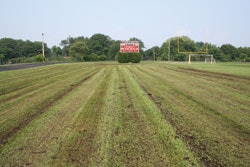By nourishing the soil first, environmental turf managers are feeding their fields naturally.
 SUSTAINABLE SOIL Topdressing with organic compost has helped transition athletic fields in Marblehead, Mass., from heavy reliance on synthetic nutrients to a more natural growing environment.
SUSTAINABLE SOIL Topdressing with organic compost has helped transition athletic fields in Marblehead, Mass., from heavy reliance on synthetic nutrients to a more natural growing environment.This past fall, the municipal stadium field in Marblehead, Mass., was covered in processed food waste - not the result of some unfortunate concessions disaster, but rather on purpose. It was the first such compost application on the field, but it may represent a growing trend in natural sports turf management.
"Because of the way the nitrogen is released, it gives pretty quick results in cooler temperatures," says Chip Osborne of Osborne Organics, who has managed Marblehead's sports fields using only natural practices for the past 10 years. "For sports turf management in the northern parts of the United States, when you're looking at some nutrient supplements in cooler soil temperatures, this particular type of a product shows a lot of promise."
Osborne, a one-time greenhouse horticulturist, made a promise decades ago to wean the plants in his care off synthetic pesticides, and by the mid-1990s he had turned his attention to turf. To be more accurate, Osborne focuses on creating quality soil - transitioning fields from a traditional peaks-and-valleys fertilization regimen (peak growth after feeding followed by a tapering off as nutrients are depleted) to a naturally sustainable growing environment. It's a process that may yield visible results within 10 days but take up to three years to complete, depending on past fertilization practices and the current condition of the field. The end result of Osborne's composting, aerating and seeding regimen (all completed in one day and done only once or twice a year) is soil that requires reduced amounts of fertilization and little, if any, herbicide and pesticide application.
Says Paul Sachs, technical liaison for North Country Organics in Bradford, Vt., and author of Managing Healthy Sports Fields: A Guide to Using Organic Materials for Low-Maintenance Chemical-Free Playing Fields (John Wiley and Sons Inc., 2004), "Even if you're trying to cultivate a weed-free sports field, you're better off having a very healthy soil, because the cool-season turf species are going to out-compete weeds if they have the right environment."
All of this is good news for the environment at large. Nitrate, a main ingredient in turf fertilizer, can leach into water tables and volatize into the atmosphere when applied in excess. Phosphate, meanwhile, can be carried away by runoff to the detriment of nearby wetlands - a process called eutrophication. "Eutrophication is a big environmental problem," Sachs says. "Nutrients, mostly phosphate, get into water systems and cause algae blooms, which consequently use up the oxygen in the water and alter the aquatic ecosystem. Fish can suffocate."
That said, Sachs feels too much of the blame for eutrophication has been attributed to turf fertilization. He cites several studies that have found unfertilized fields yield just as much or more phosphate runoff, and that healthy, phosphate-fortified turf actually aids in water filtration. He also says climatic factors such as rises in temperature and precipitation levels play an important role in ecosystem alteration. Still, phosphate as a fertilizer ingredient has become somewhat of an industry taboo; the bag of lawn food purchased at the local hardware store quite likely touts the fact that it is "phosphate free."
North Country Organics makes a phosphate-free product, too, but Sachs maintains that eutrophication risks have been overblown, mostly by politicians who are more comfortable treating the turf industry as an environmental scapegoat than they are the agriculture industry. "When you're dealing with organic fertilizers that come from organic residues of living things, you're always going to have some phosphorous in it," he says. "However, it's not in a form like triple superphosphate, where it can dissolve and then run over the ground with whatever water is running down the hill."
In general, the less-is-more approach applies to the environmental turf care movement. Though the managers of some sand-based sports fields that benefit from long growing seasons may "spoon feed" their turf just the right amount of liquefied nutrients on a weekly basis, Sachs might fertilize as infrequently as twice a year in Vermont. "I'm not a big fan of dormant feeding, but a lot of people feed turf in the late fall when the top growth is dormant and the roots are still growing," he says. "My personal feeling is that turf should be fed when it's actively growing, when it needs nutrients the most. It just makes sense. And a lot of people will tell you that they've experienced a lot more winter diseases when they dormant feed because those winter diseases are pathogens that thrive on nutrients, too. The more there is out there, the better the environment for them to proliferate."
Sachs refers to another study that looked at residential front and back lawns. Because the front lawns were what neighbors saw, "the Kentucky Bluegrass was pushed and needed to be fertilized. The lawns got regular application of herbicide and insecticide, whether they needed it or not, and it changed the balance of the biology in the soil to the point where those lawns were susceptible to more problems," Sachs says. "The back lawns had a lot of weeds that were tolerated, but they were green much longer into the dormant season and much sooner out of the dormant season, and they had no problems in terms of disease or insects. They just basically evolved into determining their own balance of plant species to survive the best, because nothing was done to them except mowing. The whole point of doing it organically is to create a diverse and active biology in the soil that will provide the checks and balances for a lot of problems."
"An organic system, specifically a sports field, is a much larger issue than a bag of fertilizer," adds Osborne. "The key is working with the natural components of the soil and understanding that it's the microbial life in the soil that ultimately is responsible for nutrient release to the grass plant."
This cycle of natural soil fertility - the consumption and nitrification of nutrients by the microbial community - is enhanced during the composting process, so long as the carbon-to-nitrogen ratio of the feed stock mix (which may amount to grass clippings, leaves, corn stalks, hay and straw, and not necessarily processed food waste) falls somewhere between 20 to 1 and 30 to 1. These ratios should be confirmed through bioassay testing, according to Osborne, who also suggests liquid or granular humic acid application as a less effective but less expensive alternative to composting. Adds Sachs, "You want to try to deal with materials that in a raw state break down slowly and mostly by biology. In biology, things break down as they're needed, so there's not a lot of excess."
"We now think of organic fertilizers as soil food, as opposed to plant food," Osborne says. "An organic fertilizer has to come in contact with microbes in the soil to become mineralized, to convert the organic form of nitrogen to the inorganic form, either ammonium or nitrate, because that's the only form the plant can use. Because that process happens very slowly over an eight-, 10- or 12-week period, we don't get runoff, we don't get leaching, we don't get volitalization back into the atmosphere."
The soil alone, no matter how rich and active, will never nourish sports turf to today's lofty quality standards. But less fertilization will be required, and liquid fertilizer may replace granular fertilizer entirely. Osborne is seeing such transformation in the fields in Marblehead, where a three-year program is under way to convert (using high-tech means) readily available organic yard waste into quality compost. It just takes a little patience. "Conventional turf management with synthetic fertilizers and pesticides is pretty much a quick-fix approach - synthetic fertilizers work in 48 hours; organics don't," Osborne says. "Ultimately, what we're aiming for in an organic program is that point three or four years down the line when the field becomes sustainable, and more of these natural processes are taking over, and we're able to reduce the amount of fertilizer and still maintain high-quality turf."





































